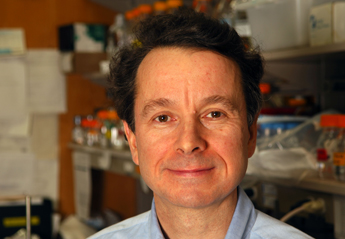
Scientific Discipline
Biophysics, Neuroscience
Related Links
Host Institution
The Rockefeller University
Current Position
Dr. MacKinnon is also a professor of molecular neurobiology and biophysics at the Rockefeller University.
Current Research
Structure and Mechanisms of Ion Channels
Research
Biography
The proper functioning of potassium channels is crucial to many biological processes, including the rhythmic beating of the heart and the generation of nerve impulses. The flow of charged potassium atoms, or ions, through these tiny, doughnut-shaped pores that penetrate cell membranes produces electrical signals that allow cells to communicate with one another.
Research by Roderick MacKinnon has literally changed the way scientists view potassium channels. In 1998, this self-taught x-ray crystallographer produced the first high-resolution three-dimensional image of the potassium channel structure, a feat that had eluded scientists for decades. This stunning accomplishment garnered MacKinnon the 2003 Nobel Prize in Chemistry and answered a question that had long perplexed scientists. Why do potassium channels freely admit large potassium ions while routinely turning away much smaller sodium ions?
MacKinnon, trained as a physician, first became interested in potassium channels as a medical resident studying how the heart contracts and relaxes. This foray into the laboratory made him realize his fascination with basic science problems. But after investing so many years in a medical education, MacKinnon was plagued with doubt: At age 30 and with no real training in basic science research, he questioned whether he could really abandon a promising career in medicine.
MacKinnon ultimately decided that life was too short to not pursue his true passion. He returned to Brandeis for a postdoctoral fellowship in the laboratory of his undergraduate mentor, biochemist and HHMI Investigator Christopher Miller, whose research focused on potassium channels.
Then, in 1989, MacKinnon went to Harvard University to run his own laboratory. There, he identified in the potassium channel a short sequence of five amino acids that acts to filter out sodium ions. If one of the amino acids in this so-called signature sequence is altered, then sodium ions rush into the channel along with the potassium ions. While this discovery and others that followed were initially exciting, MacKinnon felt increasingly frustrated. "It became clear that we couldn't understand how the potassium channel works without actually seeing it," he recalled.
Once again, MacKinnon made a gutsy move, leaving a thriving lab and secure Harvard professorship for the Rockefeller University, where he could pursue x-ray crystallography to visualize the arrangements of atoms in the potassium channel. Many of his colleagues were highly skeptical, and MacKinnon himself acknowledged that he was a novice at the technique, which takes most scientists years to master.
Only one member of MacKinnon's Harvard research group followed him to Rockefeller, and his wife, an organic chemist, joined him to help establish the new lab. "We had our periods of despair, but each time we hit a roadblock, something good happened, and our despair gave way to excitement," MacKinnon said. His persistence and dedication eventually paid off. Within two years, MacKinnon solved the structure, which he has described as "more informative and beautiful than I ever could have imagined."
The structure of the selectivity filter reveals why potassium ions are freely admitted into the channel while sodium ions are kept out. The channels are lined with oxygen atoms that mimic the electrical forces of the ions' normal watery environment. The larger potassium ions fit snugly into the channels, allowing them to pass through the cell membrane. The smaller sodium ions are denied entry because there is a greater energetic penalty to their dehydration, and because sodium ions, due to their smaller size, do not make optimal contact with the oxygen atoms in the channel.
More recently MacKinnon and his co-workers have focused their attention on how ion channels open in response to specific stimuli. Their recent atomic structures of voltage-gated, lipid-gated, G protein–gated and mechanical force–gated potassium channels have shown how cells exploit various forces in their environment to regulate their electrical activity. For example, domains known as voltage sensors "sense" the voltage difference across a cell's membrane and cause a channel within the membrane to open. This mechanism is fundamental to the production of electrical signals known as action potentials.
Understanding fundamental details of the way that these channels operate may eventually help in the design of drugs to treat many different disorders, including diabetes, heart disease, and asthma, all of which have been linked to alterations in potassium channel function.
Today, MacKinnon's laboratory draws bright young scientists from around the world, the next generation of ion channel researchers. "In addition to the science, I try to impress upon them what a great privilege it is to be a scientist," he said. "As a scientist, you spend your time trying to understand nature's rules and logic. I can't imagine a more fulfilling existence."
Articles & News
Research Papers
Selected Research Papers



